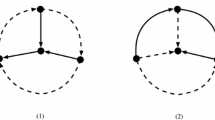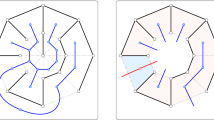Abstract
An algebraic method is proposed for the hierarchical decomposition of large-scale group-symmetric discrete systems into partially ordered subsystems. It aims at extracting “substructures” and “hierarchy” for such systems as electrical networks and truss structures.
The mathematical problem considered is: given a parametrized family of group invariant “structured” matricesA, we are to find two constant (=parameter-independent) nonsingular matricesS r andS c such thatS -1r AS c takes a (common) block-triangular form.
The proposed method combines two different decomposition principles developed independently in matroid theory and in group representation theory. The one is the decomposition principle for submodular functions, which has led to the Dulmage—Mendelsohn (DM-) decomposition and further to the combinatorial canonical form (CCF) of layered mixed (LM-) matrices. The other is the full reducibility of group representations, which yields the block-diagonal decomposition of group invariant matrices. The optimality of the proposed method is also discussed.
Similar content being viewed by others
References
M. Aigner,Combinatorial Theory (Springer, Berlin, 1979).
W.-K. Chen,Applied Graph Theory—Graphs and Electrical Networks (North-Holland, Amsterdam, 1976).
P. Diaconis,Group Representations in Probability and Statistics, Lecture Notes — Monograph Series No. 11 (Institute of Mathematical Statistics, Hayward, CA, 1988).
P. Diaconis, “Patterned matrices,” in: C.R. Johnson, ed.,Matrix Theory and Applications, Proceedings of Symposia in Applied Mathematics, Vol. 40 (American Mathematical Society, Providence, RI, 1990) pp. 37–58.
A.L. Dulmage and N.S. Mendelsohn, “A structure theory of bipartite graphs of finite exterior dimension,”Transactions of Royal Society of Canada, Section III, 53 (1959) 1–13.
M. Hamermesh,Group Theory and its Application to Physical Problems (Addison—Wesley, Reading, MA, 1962).
M. Iri,Network Flow, Transportation and Scheduling — Theory and Algorithms (Academic Press, New York, 1969).
M. Iri, “Applications of matroid theory,” in: A. Bachem, M. Grötschel and B. Korte, eds.,Mathematical Programming — State of the Art (Springer, Berlin, 1983) pp. 158–201.
M. Iri, “Structural theory for the combinatorial systems characterized by submodular functions,” in: W.R. Pulleyblank, ed.,Combinatorial Optimization (Academic Press, New York, 1984) pp. 197–219.
N. Jacobson,Basic Algebra II (Freeman, San Francisco, CA, 1980).
E.L. Lawler,Combinatorial Optimization: Networks and Matroids (Holt, Rinehart and Winston, New York, 1976).
L. Lovász and M. Plummer,Matching Theory (North-Holland, Amsterdam, 1986).
W. Miller, Jr.,Symmetry Groups and their Applications (Academic Press, New York, 1972).
K. Murota,Systems Analysis by Graphs and Matroids — Structural Solvability and Controllability, Algorithms and Combinatorics, Vol. 3 (Springer, Berlin, 1987).
K. Murota, “On the irreducibility of layered mixed matrices,”Linear and Multilinear Algebra 24 (1989) 273–288.
K. Murota, “Some recent results in combinatorial approaches to dynamical systems,”Linear Algebra and its Applications 122/123/124 (1989) 725–759.
K. Murota, “Hierarchical decomposition of symmetric discrete systems by matroid and group theories,” Technical Report METR 90-20, Department of Mathematical Engineering and Information Physics, University of Tokyo (Tokyo, 1990).
K. Murota, “On the Smith normal form of structured polynomial matrices,”SIAM Journal on Matrix Analysis and its Applications 12 (1991) 747–765.
K. Murota, “A mathematical framework for combinatorial/structural analysis of linear dynamical systems by means of matroids,” in: B. Donald, D. Kapur and J. Mundy, eds.,Symbolic and Numerical Computation for Artificial Intelligence (Academic Press, Cambridge, MA, 1992) pp. 221–224.
K. Murota, “Mixed matrices: irreducibility and decomposition,” in: A. Brualdi, S. Friedland and V. Klee, eds.,Combinatorial and Graph-Theoretical Problems in Linear Algebra, The IMA Volumes in Mathematics and its Applications (Springer, Berlin, 1992) pp. 000–000.
K. Murota and M. Iri, “Structural solvability of a system of equations — a mathematical formulation for distinguishing accurate and inaccurate numbers in structural analysis of systems,”Japan Journal of Applied Mathematics 2 (1985) 247–271.
K. Murota, M. Iri and M. Nakamura, “Combinatorial canonical form of layered mixed matrices and its application to block-triangularization of systems of equations,”SIAM Journal on Algebraic and Discrete Methods 8 (1987) 123–149.
M. Nakamura, “Structural theorems for submodular functions, polymatroids and polymatroid intersections,”Graphs and Combinatorics 4 (1988) 257–284.
A. Recski,Matroid Theory and its Applications in Electric Network Theory and in Statics, Algorithms and Combinatorics, Vol. 6 (Springer, Berlin, 1989).
J.-P. Serre,Linear Representations of Finite Groups (Springer, Berlin, 1977).
N. Tomizawa, “Strongly irreducible matroids and principal partition of a matroid into strongly irreducible minors,”Transactions of Institute of Electric and Communication Engineers J59A (1976) 83–91. [In Japanese.]
B.L. van der Waerden,Algebra (Springer, Berlin, 1955).
D.J.A. Welsh,Matroid Theory (Academic Press, New York, 1976).
N. White,Theory of Matroids (Cambridge University Press, London, 1986).
Author information
Authors and Affiliations
Rights and permissions
About this article
Cite this article
Murota, K. Hierarchical decomposition of symmetric discrete systems by matroid and group theories. Mathematical Programming 59, 377–404 (1993). https://doi.org/10.1007/BF01581254
Received:
Revised:
Issue Date:
DOI: https://doi.org/10.1007/BF01581254




